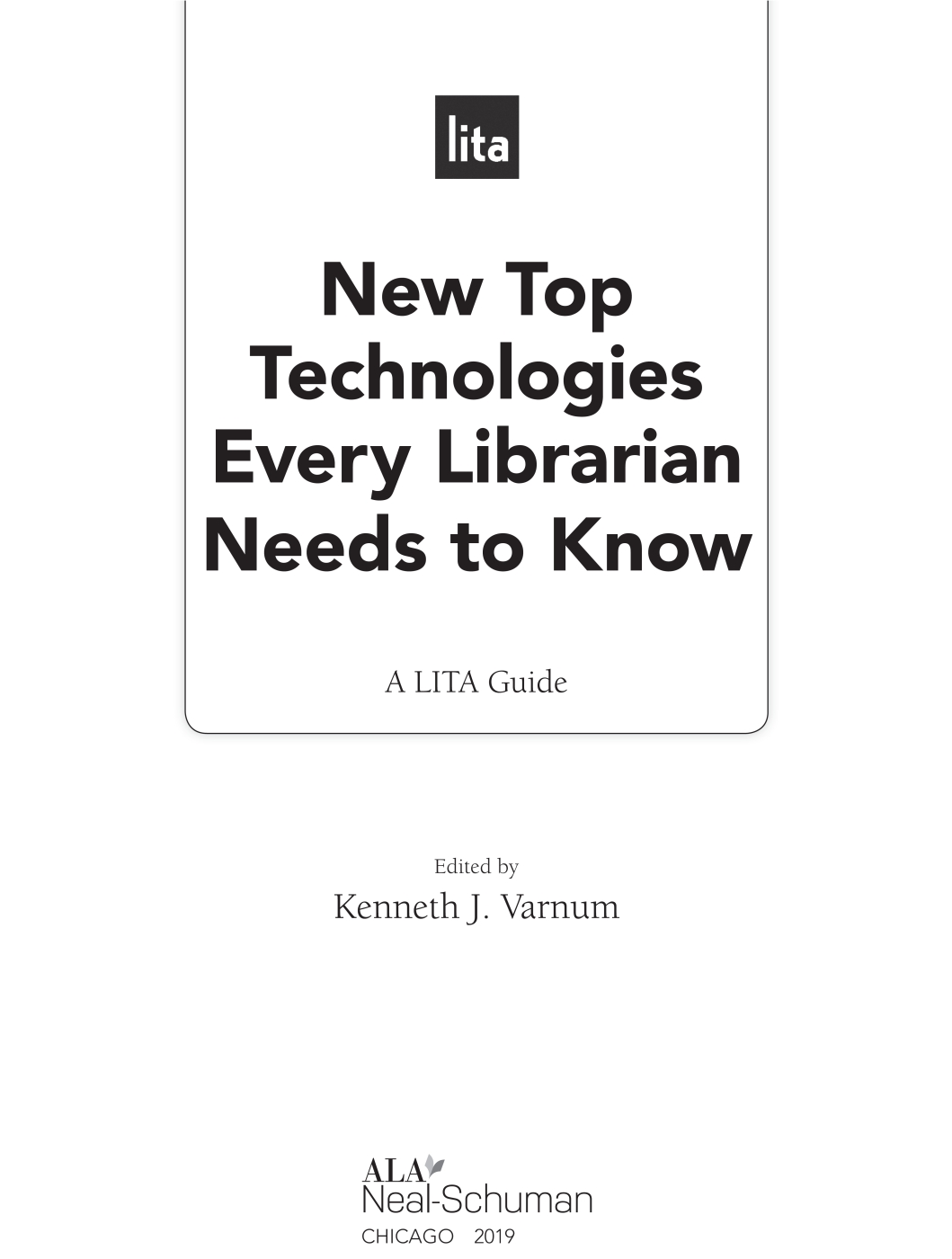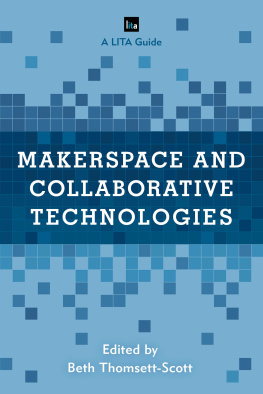
ALA Neal-Schuman purchases fund advocacy, awareness, and accreditation programs for library professionals worldwide.

KENNETH J. VARNUM is the senior program manager at the University of Michigan Library. In this role, Ken is responsible for the librarys discovery systems, document delivery and link resolver interfaces, and the librarys evolving and emerging analytics infrastructure. He received his masters degrees from the University of Michigans School of Information and Center for Russian and East European Studies and his bachelor of arts from Grinnell College. Over his two decades working with public-facing technology in academic, corporate, and special libraries, he has gained a deep appreciation and understanding of the need to tailor systems and interfaces to the local user base. A frequent speaker and author, Ken presents and writes about discovery systems, library analytics, and technology. In addition to numerous articles and chapters, he wrote Drupal in Libraries (2012), compiled the LITA Guide The Top Technologies Every Librarian Needs to Know and Exploring Discovery: The Front Door to Your Librarys Licensed and Digitized Content (2016), and edited Lorcan Dempseys The Network Reshapes the Library (2014). Contact Ken through his website at www.varnum.org or on Twitter at @varnum.
2019 by the American Library Association.
Extensive effort has gone into ensuring the reliability of the information in this book; however, the publisher makes no warranty, express or implied, with respect to the material contained herein.
ISBNs
978-0-8389-1782-4 (paper)
978-0-8389-1803-6 (PDF)
978-0-8389-1805-0 (ePub)
978-0-8389-1804-3 (Kindle)
Library of Congress Cataloging-in-Publication Data
Names: Varnum, Kenneth J., 1967 editor.
Title: New top technologies every librarian needs to know / edited by Kenneth J. Varnum.
Description: Chicago : ALA Neal-Schuman, An imprint of the American Library Association, 2019. | Series: A LITA guide | Includes index.
Identifiers: LCCN 2018043367 | ISBN 9780838917824 (print : alk. paper) | ISBN 9780838918036 (pdf) | ISBN 9780838918050 (epub) | ISBN 9780838918043 (kindle)
Subjects: LCSH: LibrariesInformation technology. | Libraries and the Internet. | Digital libraries.
Classification: LCC Z678.9 .N455 2019 | DDC 027.00285dc23 LC record available at https://lccn.loc.gov/2018043367
Cover image Adobe Stock.
I dedicate this book to Elliott and Milo, who change even faster than the technologies that they are growing up with.
Contents
Cliff Landis
Matthew Connolly
Justin M. White
Todd Suomela
Monica Maceli
Julia Bauder
Elizabeth Joan Kelly
Austin Olney
Daniel Johnson and Mark Dehmlow
Joshua A. Westgard, Kate Dohe, David Durden, and Joseph Koivisto
Jessica Wagner Webster
Ellen Engseth and Marguerite Ragnow
Kelli Babcock and Rachel Di Cresce
Lauren Magnuson
Jeanette Claire Sewell
Alan Darnell
Gordon F. Xu and Jin Xiu Guo
T he original Top Technologies Every Librarian Needs to Know was published in 2014. Similar to what this volumes authors were asked to do, the authors of the 2014 edition were tasked with thinking about technologies that were relatively new then (either new in general or perhaps somewhat well-established but still novel to libraries) and forecast what libraries would be like in three to five years when that technology had become part of the landscape. Now that we have reached that five-year horizon (2018) from when the first editions authors were writing (in 2013), it seems a good time to review the predictions from the first set of chapters and, with a different group of authors, take a gaze into 2018s near-term future with a new set.
A LOOK BACK
The original book focused on these broad trends: content and technology convergence, augmented reality, cloud-based library systems, discovery systems, web services, text mining, large-scale digital libraries, and open hardware. Some of these technologies are still being adopted, whereas others have become firmly entrenched in the routine of libraries. For example, text mining, large-scale digital libraries, and cloud-based library systems have become core to what many institutions do. The race to the cloud for many back-end (and user-facing) services continues apace. Discovery layers on top of whatever suite of resources a library offers its clientele are still common; the desire to provide access to the breadth of a librarys content is still strongbut with increasing recognition that one-size-fits-all discovery interfaces do not necessarily meet all the needs of all the users.
Other technologies are still on the rise, with potentials constantly being explored. Augmented and virtual reality technologies described in 2014 are now becoming technologically possible as the tools to support them become cheaper. Content and technology convergence, in which users bring their own desires for how they wish to consume the content they seek and libraries can offer multiple formats to meet those needs, is still actively developing. Open hardware and the Internet of Things are still tantalizingly at hand but not quite commonplace.
A LOOK AHEAD
Like the original volume, chapters in New Top Technologies Every Librarian Needs to Know are structured around a rough topical outline, but authors were free to adopt a style they wanted. In each of this books chapters, you will find a description of a technology or trend as it exists in the world in early 2018; how it is being used in libraries, archives, or museums by its early adopters; and what the future will look like if, as the authors envision, the technology is widely adopted in the next three to five years.
The book is organized into four parts, each looking at a broad swathe of library activity: Data, Services, Repositories and Access, and Interoperability. explores ways that libraries are beginning to enhance their offerings to their particular patron base. The chapters cover patron privacy protection, data and data visualization, and virtual reality.
covers standards (IIIF and LTI), interoperability of content and tools, and the ever-expanding functionality of mobile devices for access.
Kenneth J. Varnum
Ann Arbor, Michigan
January 2019
Data
Linked Open Data in Libraries
Cliff Landis
M ost library users will interact with linked data about your library before they ever interact with the library itself. If a user does a web search on Google for your librarys name, they will see a summary of the librarys vital information displayed in a knowledge panel to the right of their search results. This box displays information pulled from Googles proprietary Knowledge Graph, a specialized database of aggregated facts.
If your user prefers Wikipedia as a starting point, a quick search for the library will pull up a Wikipedia page that includes an infobox that again is populated with linked data facts. These were initially pulled to Wikidata, the linked open-data knowledgebase used to tie together facts across Wikimedia projects and languages. Under the menu of every Wikipedia page is a link to the Wikidata item for that page. On that Wikidata page, you can add more details about your library or correct erroneous information (with proper secondary source citations, of course). Unlike Googles Knowledge Graph (linked proprietary data), Wikidata facts can be edited and reused under a Creative Commons license (linked
Next page











